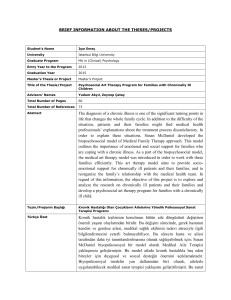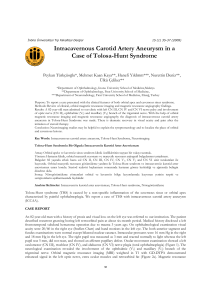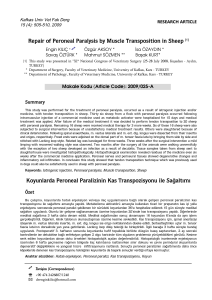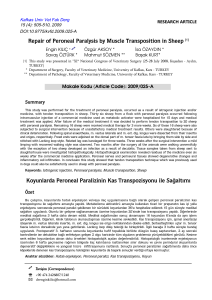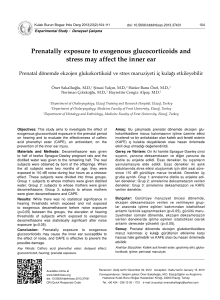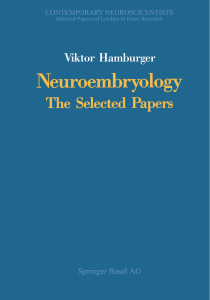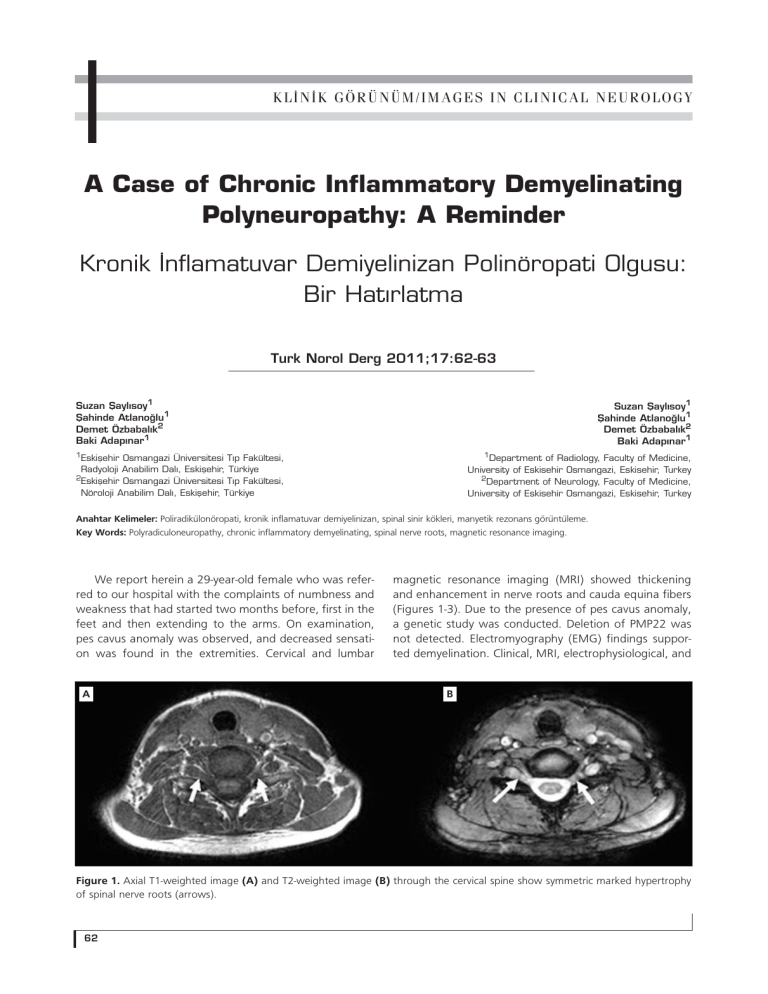
KL‹N‹K GÖRÜNÜM/IMAGES IN CLINICAL NEUROLOGY
A Case of Chronic Inflammatory Demyelinating
Polyneuropathy: A Reminder
Kronik İnflamatuvar Demiyelinizan Polinöropati Olgusu:
Bir Hatırlatma
Turk Norol Derg 2011;17:62-63
Suzan fiayl›soy1
fiahinde Atlano¤lu1
Demet Özbabal›k2
Baki Adap›nar1
Suzan fiayl›soy1
fiahinde Atlano¤lu1
Demet Özbabal›k2
Baki Adap›nar1
1Eskişehir
1Department
Osmangazi Üniversitesi Tıp Fakültesi,
Radyoloji Anabilim Dalı, Eskişehir, Türkiye
2Eskişehir Osmangazi Üniversitesi Tıp Fakültesi,
Nöroloji Anabilim Dalı, Eskişehir, Türkiye
of Radiology, Faculty of Medicine,
University of Eskisehir Osmangazi, Eskisehir, Turkey
2Department of Neurology, Faculty of Medicine,
University of Eskisehir Osmangazi, Eskisehir, Turkey
Anahtar Kelimeler: Poliradikülonöropati, kronik inflamatuvar demiyelinizan, spinal sinir kökleri, manyetik rezonans görüntüleme.
Key Words: Polyradiculoneuropathy, chronic inflammatory demyelinating, spinal nerve roots, magnetic resonance imaging.
We report herein a 29-year-old female who was referred to our hospital with the complaints of numbness and
weakness that had started two months before, first in the
feet and then extending to the arms. On examination,
pes cavus anomaly was observed, and decreased sensation was found in the extremities. Cervical and lumbar
A
magnetic resonance imaging (MRI) showed thickening
and enhancement in nerve roots and cauda equina fibers
(Figures 1-3). Due to the presence of pes cavus anomaly,
a genetic study was conducted. Deletion of PMP22 was
not detected. Electromyography (EMG) findings supported demyelination. Clinical, MRI, electrophysiological, and
B
Figure 1. Axial T1-weighted image (A) and T2-weighted image (B) through the cervical spine show symmetric marked hypertrophy
of spinal nerve roots (arrows).
62
Şaylısoy S, Atlanoğlu Ş, Özbabalık D, Adapınar B.
Kronik İnflamatuvar Demiyelinizan Polinöropati
Figure 2. Sagittal T2-weighted image demonstrates thickening of cauda equina fibers and spinal nerve roots. Signal changes relating to a previous operation are also seen in the cutaneous-subcutaneous region.
A
B
Figure 3. Axial T1-weighted post-contrast image, at the approximate level of Figure 1, demonstrates enhancing cervical spinal nerve roots (arrows) (A). Diffuse thickening and enhancing of nerve roots are exhibited on T1-weighted post-contrast image (arrows) (B).
cerebrospinal fluid (CSF) findings supported chronic inflammatory demyelinating polyradiculoneuropathy (CIDP).
The patient was given intravenous immunoglobulin treatment for one week, and clinical findings regressed following the treatment. CIDP is a chronic peripheral nerve disease in which selective myelin damage occurs (1). It is
characterized by a sensorimotor disorder in the extremities that shows a course with recovery and relapse periods.
Turk Norol Derg 2011;17:62-63
REFERENCE
1.
Tazawa K, Matsuda M, Yoshida T, Shimojima Y, Gono T, Morita H, et
al. Spinal nerve root hypertrophy on MRI: clinical significance in the diagnosis of chronic inflammatory demyelinating polyradiculoneuropathy.
Intern Med 2008;47:2019-24.
gelifl tarihi/received
09/02/2011
kabul edilifl tarihi/accepted for publication
08/03/2011
63

